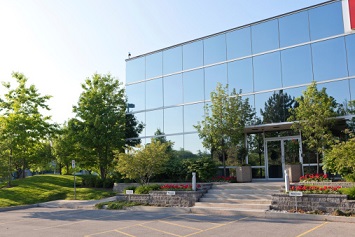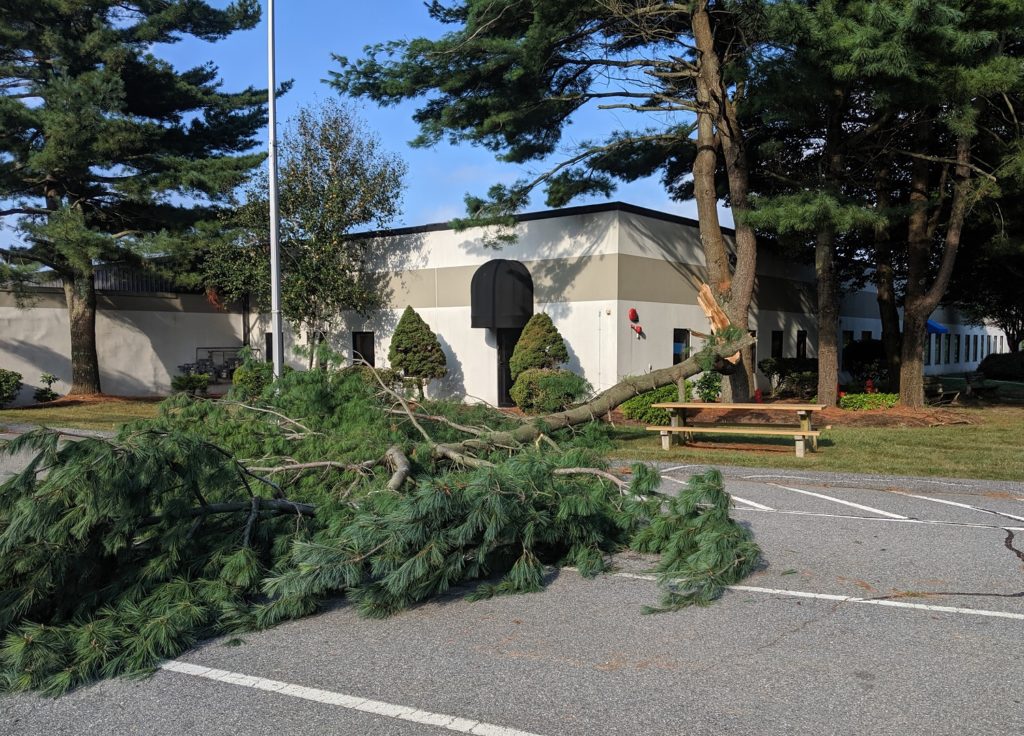To a facility manager, a picture can be worth a thousand words, and the trees on their facility grounds are an important part of that image. Their value also extends well beyond the ornamental; healthy trees help curb cooling costs, manage stormwater, clean the air by intercepting pollutants, and provide some shade where your or your tenant’s employees can gather for lunch on a nice day. On the flip side, however, a picture can also capture a moment in time when they narrowly avoided thousands of dollars in property damage and liability claims.
Driving into our facility’s parking lot this morning, it was difficult to ignore the scene in the image below. At some time between the close of business and the start of the next business day, a large bough from an eastern white pine cracked and fell, taking up several parking spots, much of the walkway leading to a recently vacated unit, and almost crushing a newly restored picnic table. What you can’t see is the day care center off to the right of the image, or the parked cars of parents walking past the limb while dropping off their small children.
If the fallen bough waited until this morning to give way, it easily could have damaged a car, a prospective tenant looking at the unoccupied unit, seriously injured some of the people regularly having coffee at the picnic table, or sent a child to the hospital.
Do You Account for Tree Health on Your Facility’s Grounds?
There are many factors that can affect tree health and turn them into potential hazards. Maybe they suffered damage during a recent storm, either from wind, lightning, or accumulated precipitation. For example, in winter, should heavy, wet snow or ice collect on branches (or leaves if the storm comes early enough) there’s an increased risk that the branch will snap off and crash to the ground. In some instances, the weight of the branch or force of the break will be enough to split or twist part of the tree trunk. In a worst-case scenario, the entire tree could topple.
It’s also possible for a bug infestation to silently inflict damage over the long term, or, in some cases, rapidly damage a tree by over-feeding on its leaves.
Warning Signs of an Unhealthy Tree
So, what signs point to a healthy tree, and when should you call an arborist out for an inspection? Here are some factors to watch for:
- Any limbs that are dead or only partially attached that are resting on other branches. These could easily fall, leading to injury or property damage;
- Cracks in branches, particularly near branch forks;
- Any areas that suggest decay, such as hollows on the trunk, or any kind of fungal growth out of the bark;
- Peeling bark, or, any other visible damage to the protective layer;
- A tree that is bearing the weight of another fallen or partially up-rooted tree;
- Rising soil at the base of the trunk, which could signal that there are issues with the root system.
If you see any of these signs, it’s best to call in a professional arborist to fully inspect the tree, and to take care of any needed work before it becomes a liability.
If a tree on your property has recently been damaged in a storm, it’s best to call a professional to handle the cleanup. This is especially true if the damage happened near a power line. Fallen trees or branches can easily obscure a downed line, and the results of contact with a live powerline are all too often fatal.
If you have questions, or need help making a determination regarding the health of your trees, the Tree Care Industry Association is a good resource for helping you find a path forward.


